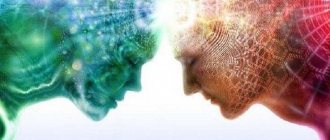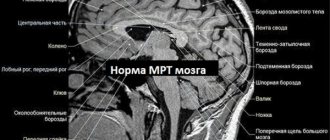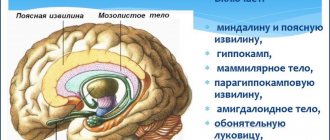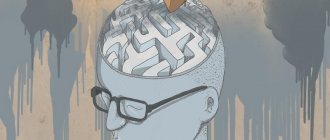Acalculia (a + lat. calculo - to count) is presented in the form of a neuropsychological symptom, the peculiarity of which is the loss of the ability to perform arithmetic operations due to lesions of the cerebral cortex. A synonym for acalculia is dyscalculia.
Patients lack the ability to compare numbers, subtract and add them, and solve basic mathematical problems.
In essence, a person’s ability to count is the simultaneous integration of several cognitive skills. The pathology under consideration provokes difficulties in the following areas:
- association of number and its spoken name;
- comparison of numbers with different numerical values;
- registering the meaning of a number in the mind and understanding its essence;
The symptoms of acalculia are often a precursor to dementia, the cause of which is the presence of lesions in the frontal or parietal lobe of the brain.
Reasons for the development of the disorder
Acalculia is an acquired disease that develops due to damage to certain areas of the brain. The cause may be injury or the development of tumors. Very often, acalculia develops against the background of a mental disorder.
The brain damage in which the disease develops is concentrated in the parietal, occipital and temporal cortex of the brain. The causes of such lesions may be:
- Heredity.
- Various neurological disorders during the perinatal period.
- Tumors in the brain.
- Intoxication of varying degrees of intensity.
- Brain damage due to the development of infectious diseases.
- Negative impact of the social environment.
- Traumatic brain injuries.
- Cerebrovascular diseases.
As a rule, this is a symptom of some mental illness, but acalculia can also act as an independent pathology.
Implications and Limitations
Acalculia can cause various complications. Such negative consequences include (difficulties in composing and perceiving sentences), paraphasia (replacement of sounds, incorrect use of sounds), speech embolus (obsessive repetition of a word or phrase).
The consequences of acalculia also include a decrease in an individual’s social adaptation due to a combination of the disease with other cognitive impairments. As a result, the patient's quality of life decreases.
When the disease develops in children, this causes problems in learning, social adaptation at school, impairs communication skills and can negatively affect the child’s further cognitive development. Children may develop low self-esteem and depression.
Dyscalculia is the inability to operate with mathematical categories, the inability to understand the essence of arithmetic operations, the concepts of “number”, “sum”, “triangle” and the like. As a rule, this disorder appears in children of preschool and primary school age, but it can also occur in adults. Dyscalculia is difficult to diagnose for a non-specialist, so children with this pathology often end up in specialized classes for schoolchildren with mental development disorders.
Approximately 10% of schoolchildren suffer from some form of dyscalculia. Not all parents know that with timely diagnosis even in preschool age, effective measures can be taken to prevent this pathology and make it easier for the child to master the school curriculum.
If a child suffers from manifestations of dyscalculia, he experiences a negative attitude towards the “exact sciences”. Chronic underachievement can also affect mastery of humanities subjects, as well as cause a student’s low social status. He does not have good relationships with his peers, and teachers and parents often put unjustifiably strong pressure on him because of his perceived laziness and lack of diligence. In the future, such children experience difficulties with choosing a profession and self-realization.
- Fear of arithmetic - the violation is based on the negative experience of learning to count through coercion and punishment. This unusual phobia is due to the fact that when solving arithmetic examples, especially problems, the child had difficulties or was often scolded and punished. Over time, he developed fear and self-doubt for fear of being punished.
- Social problems. They most often occur in children who are brought up in conditions of pedagogical neglect, in a dysfunctional family.
- Damage to the parietal lobe of the cerebral cortex due to the pathology of pregnancy and childbirth, brain injuries and neuroinfections, tumors and genetically determined defects.
In adults, this problem often appears due to disruption of the brain. Its occurrence can be caused by hemorrhages, organic lesions in the temporal region, tumors, blood clots, cysts and traumatic brain injuries. Various psychological traumas can also provoke the occurrence of dyscalculia. If you have problems using mathematical knowledge, you should contact a neuropsychiatrist.
Dyscalculia in children often occurs due to disorders of mental activity. These include:
- disturbance in the processing of visual information;
- decreased concentration;
- violation of logical thinking;
- problems with assimilation and memorization of information.
Dyscalculia can be combined with reading and writing disorders such as dysgraphia and dyslexia, as well as ADHD (attention deficit hyperactivity disorder).
Aspects of the syndrome
For the first time, information about such a disease as acalculia appeared in 1919. Based on the results of the research, the pathology was divided into primary and secondary. The primary form develops with damage to the temporal, parietal and occipital parts of the cerebral cortex. With this development, the patient’s ability to analyze and synthesize spatial representations is impaired.
The patient cannot distinguish the numbers or perform any actions with them. Doctors have established the fact that the difficulty arises due to a person’s lack of understanding of “left, right, up, down.”
These disorders are most difficult in children. The child may not develop an understanding of space by the time he starts school. This will lead to the inability to master arithmetic numbers.
Symptoms of primary acalculia are:
- No difference between numbers. For example, the patient does not understand the difference between 545 and 455.
- Inability to differentiate between digits of numbers.
- Complete lack of concept of number.
- Misunderstanding of spatial coordinates.
- Difficulty performing any type of arithmetic operations.
The secondary type of pathology is observed with a general disorder of mental activity or with mental disorders.
Types of disease
Depending on the manifestation, there are many types of acalculia.
Verbal
Characterized by difficulties in denoting mathematical terms, concepts and operations verbally. It is quite possible that the patient is fluent in arithmetic, but cannot express it.
Apraxic
A person is not able to independently determine the number of objects that are nearby.
Dyslexic
It manifests itself in the fact that the patient suffers defeats in attempts to read some arithmetic sign or symbol. It is believed that this type of disorder can be transmitted at the genetic level.
Graphic
In this case, the name speaks for itself; graphic acalculia deprives a person of the ability to display mathematical operations in writing. Such a person will not even be able to draw a basic geometric figure.
operating room
During the operational type of disorder, it will be almost impossible for the patient to perform arithmetic operations: add, subtract, divide and multiply. Perhaps this will manifest itself partially. For example, a person copes well with subtracting numbers, but cannot multiply them.
Primary
Scientists believe that the disease of primary acalculia has no connection with disorders of other mental functions. It appears due to damage to the left hemisphere of different areas of the cerebral cortex: frontal or parietal.
Frontal
Impaired functioning of the frontal lobes of the brain leads to loss of conscious activity in a person. Thus, the individual cannot perform precise mathematical operations.
Parietal
Occurs as a loss of spatial thinking. Accordingly, the patient cannot understand the concept of “numbers” and everything connected with them.
Secondary
It is part of a neuropsychiatric syndrome that already exists in the individual. It appears as a result of a lack of ability for purposeful mental functions. Secondary acalculia has several subspecies.
Optical
A variety that appears due to problems with vision receptors. The patient literally cannot distinguish one number from another.
Sensory
As a consequence of problems with the temporal areas of the cerebral cortex, sensory acalculia develops. Because of this, the patient loses the ability to count verbally.
Acoustic-mnemonic
If the prefrontal areas of the brain are affected, then an acoustic-mnemonic type of disorder may begin. It is expressed in the fact that the person cannot perceive any arithmetic terms or commands by ear.
Development of the disease in children
At school age, about 5 percent of children suffer from dyscalculia. This is a misunderstanding of the principle of counting, the inability to distinguish between arithmetic operations. Acalculia and dyscalculia are interrelated diseases.
We are talking about acalculia if the child was mentally developed, but lost his ability as a result of injury or disease. With dyscalculia, the child loses the ability to learn any arithmetic operation, and often this is combined with the problem of the inability to recognize letters.
Dyscalculia in children begins to develop from an early age. It is expressed in the fact that it is simply impossible to teach such a child any arithmetic operations. His brain completely refuses to perceive this information. Most often, this disease occurs in children with a genetic predisposition. As a result, the disease develops into mental retardation.
Types and forms of the disease
The development of acalculia occurs with disorders of various cognitive systems. Depending on which cognitive function is affected, the following types of disease are distinguished:
- Verbal – deviations in the verbal designation of mathematical concepts. The patient can successfully perform mathematical operations, but cannot verbally indicate the names of numbers, symbols, and is unable to indicate the number of objects.
- Apraxic – a person is unable to count objects. The patient cannot count objects and identify their quantitative characteristics.
- Dyslexic – lack of ability to read mathematical symbols and express quantitative terms.
- Graphic – the inability to write down mathematical symbols and signs, as well as to correctly depict geometric figures.
- Operational – loss of ability to perform mathematical operations.
Also, cases of acalculia can be divided on the basis of primary and secondary.
Primary (specific) – caused by lesions of areas of the cerebral cortex, the following types are distinguished:
- Frontal - caused by dysfunction of the frontal lobe of the brain, which is responsible for the control and regulation of all human mental functions. The ability to count is impaired due to deviations in the organization of conscious activity.
- Parietal (parieto-occipital) - occurs when the parieto-occipital areas of the brain are damaged. The patient’s concept of “number”, understanding of the essence of counting operations, and perception of spatial coordinates are impaired.
Secondary (nonspecific) – occurs due to a neuropsychiatric disease, the following types are distinguished:
- Optical - occurs with pathologies of the lobes of the brain responsible for the visual analyzer. With optical acalculia, the visual perception of numbers and mathematical symbols is impaired. The patient is unable to distinguish between similar arithmetic symbols and recognize Roman numerals.
- Sensory – develops with damage to areas of the brain involved in the acoustic perception of speech. Manifests itself in difficulties with oral counting and carrying out counting operations by ear.
- Acoustic-mnemonic – also associated with the acoustic perception of speech. The difference is that the patient has impaired auditory-verbal memory and a reduced volume of auditory perception.
Difference from dyscalculia
Acalculia and dyscalculia are similar concepts, but there are differences between them. It lies in the fact that dyscalculia is a consequence of congenital disorders of brain development and with it mathematical knowledge is not fully absorbed. Acalculia is an acquired condition, and occurs due to neurological injuries and disorders acquired during life.
Diagnosis of dyscalculia
Parents can see dyscalculia in children themselves; if pathology manifests itself, they should immediately consult a doctor. The specific type of disease is determined after consultation with a speech therapist, neurologist, or psychologist.
When a child talks with doctors, he is asked to count, perform a simple arithmetic operation, and arrange cards with numbers in decreasing or increasing order. Depending on the violations identified during the execution of tasks, the type of disease will be determined.
The types of dyscalculia are as follows:
- Graphic – the child cannot write down numbers and mathematical symbols. He has difficulty depicting geometric shapes.
- Verbal - the patient experiences difficulty when asked to name an arithmetic operation.
- Dyslexic - this form of the disease manifests itself in the inability to read mathematical symbols.
- Operational – the inability to perform an arithmetic operation.
Establishing the type of pathology allows for the most effective correction of dyscalculia.
Symptoms of the problem
Children suffering from dyscalculia are not able to understand what a number is and on what principle the number series is built; they cannot distinguish and remember numbers. They cannot perform operations with numerical values and do not know how to decompose them into terms. It is difficult for them to compare the number of objects, perform simple arithmetic operations and carry out calculations according to the internal plan, that is, to count “in their minds”.
Symptoms of dyscalculia:
- difficulty recognizing and writing numbers;
- inability to tell time and navigate hours, minutes, seconds;
- impaired coordination of fine movements;
- inability to determine the distance traveled or measure the length of a segment;
- difficulty in perceiving the concepts “less” and “more”;
- the impossibility of solving problems without illustrative support;
- difficulties in solving logical problems and performing actions with abstract categories;
- inability to visually determine the number of objects, putting them into groups without counting them one by one.
As soon as relatives discover the above symptoms in a child, you should immediately seek advice from a speech therapist or psychotherapist. The specialist will conduct a differential diagnosis, determine the form of the disorder, identify the causes of its occurrence and develop an effective correction method.
Due to a violation in the processing of visual information, the child can solve examples only if their objective component is present. The child cannot independently imagine what is written in the task conditions. In addition, schoolchildren in primary grades are unable to rationally calculate their free time, which leads to poor academic performance and behavior problems in the future. This aspect is described quite fully in the video below:
Treatment
Acalculia is treatable, but to completely eliminate the symptoms, it is necessary to eliminate the cause of the pathology, the disease that caused the disorders. A different situation arises with dyscalculia. Since this disease is not acquired, but congenital, treatment involves only correction and preventive measures.
Treatment methods for acalculia will depend on the patient's age and the severity of the disease. If an adult is sick, therapy will be carried out with specialists using various computer programs. The patient is gradually brought to awareness of the concept of number. After this, learning mathematical operations begins, from simple to more complex.
For children, treatment is based on play. Most often, pictures with numbers are used for this. The child is visually taught to distinguish numbers.
Correction of dyscalculia should be carried out by a speech therapist. If necessary, a psychologist and a neurologist can be involved in working with the patient. Special techniques are being developed for correction. Classes can take place in any place comfortable for the child. The technique consists of a whole set of game exercises that teach counting. Also, classes should be aimed at developing the child’s speech, thinking, and visual abilities.
To eliminate dyscalculia, it is very important to develop competent and coherent speech. Correction should be based on expanding the child’s vocabulary while simultaneously learning mathematical terms. at the very beginning, an understanding of more, less, the name of geometric figures, and the characteristics of an object should be introduced.
The next stage introduces teaching ordinal counting and the use of numbers in speech. The child is taught to compare numbers, objects, their quantity, and quality characteristics. The child forms a connection between a number and its visual expression in writing. Both fine motor skills and thinking develop immediately.
As soon as stable achievements in counting are achieved, the teacher moves on to simple arithmetic operations. The goal is to show the child the logic of the solution.
Clinical and psychological characteristics of acalculia and dyscalculia in childhood
Tatyana Lakhtina
Clinical and psychological characteristics of acalculia and dyscalculia in childhood
«Clinical and psychological characteristics of acalculia and dyscalculia in childhood»
Content
Introduction page 3
1. Clinical and psychological characteristics of acalculia p.. 5
2. Clinical and psychological characteristics of dyscalculia p.. 8
Conclusion page 11
References page 13
Introduction
Until now, not only in our country, but also in foreign countries, books on counting disorders, and especially on methods for overcoming it, are numbered in units. The paucity of research into acalculia and the development of methods to overcome it is due to a number of reasons. One of them is the fact that acalculia is included in the syndrome of almost all forms of aphasia, in which speech impairment often masks defects in counting and counting operations. Therefore, the priority task has always been to restore speech, which (historically)
Speech therapists were involved.
Psychologists and neuropsychologists became involved in this work and in scientific research in this area much later. In the absence of sufficient time to work with patients in the clinic , it is natural that, first of all, patients were taught to speak and understand speech, write and read, and there was no time left for classes to overcome difficulties in counting. Therefore, the research and methodological aspects of acalculia have not received proper development.
Another reason can be considered the difficulty of the subject of study itself - the psychology of counting and counting operations, the concept of the bit structure of numbers, types and causes of their violation, the connection of counting with thinking, speech, cognitive processes, etc. As a consequence of these difficulties, obstacles arose to the development of methods for overcoming this the most complex type of intellectual activity. Acalculia is a violation of the ability to perform arithmetic operations caused by damage to the cortex of the left hemisphere of the brain. Rarely seen in isolation, often combined with aphasia
Dyscalculia is a specific disorder of learning to count, manifesting itself at different ages in the preschool and school populations.
Dyscalculia is caused by a number of mechanisms that combine the immaturity of higher mental functions involved in the process of mastering numeracy skills (attention, memory, abstract logical thinking, visual-spatial and visual-perceptual gnosis, emotional-volitional reactions.
The objectives of this work include:
1) consideration of the clinical and psychological characteristics of acalculia ;
2) study of the clinical and psychological characteristics of dyscalculia .
1. Clinical and psychological characteristics of acalculia
Acalculia is a violation of the ability to perform arithmetic operations caused by damage to the cortex of the left hemisphere of the brain. Rarely seen in isolation, more often combined with aphasia 1
Acalculia (from Greek a negative particle and Latin calculatio account, calculation)
neuropsychological symptom described by SE Henschen in 1919.
Characterized by violation of counting operations.
Primary acalculia, as a symptom independent of other disorders of higher mental functions, is observed with damage to the parieto-occipitotemporal cortex of the left hemisphere and represents a violation of the understanding of spatial relationships, lack of understanding of the transition through ten associated with the bit structure of a number, failure to distinguish arithmetic signs, etc.
Secondary acalculia , which is part of the structure of a particular neuropsychological syndrome, can occur with damage to the temporal parts of the cerebral cortex, when oral counting is impaired, the occipital areas, when numbers similar in writing are not distinguished, and the prefrontal areas, when purposeful activity and planning of counting operations are impaired and monitoring their implementation.
Primary acalculia . A rare form of acalculia , in which counting disorders are found on their own, regardless of other disorders of higher cortical functions. Secondary acalculia is spoken of in cases where counting disorders are part of the structure of a neuropsychological syndrome in combination with memory impairment, aphasic symptoms, and pronounced perseverations.
The most common is primary acalculia , which occurs when the parietal parts of the brain are damaged. This form is the main one - here arithmetic operations are violated from their essential side. Patients lose their understanding of spatial reference schemes, their concept of number and the concept of digit capacity of its recording are disrupted. Often these patients do not understand the meaning of arithmetic signs and cannot carry out the actions indicated by them.
The training of patients in this group is aimed primarily at restoring spatial reference schemes, at restoring the concept of number (its composition and digit capacity, understanding the composition of arithmetic operations, etc. At a certain stage of training, a significant role belongs to loud speech - pronunciation.
Arithmetic operations may also be impaired if the frontal systems of the brain are damaged. In this case, their violations take on a different picture. They do not affect the essential side of actions, but concern them only secondary and are the result of the collapse of general forms of intellectual activity.
There are violations of arithmetic operations occurring in the syndrome of inactivity, increased inertia of stereotypes, motor and speech perseverations (damage to the posterior frontal parts of the brain, then in the syndrome of general disinhibition of behavior, decreased concentration of attention, impulsivity (damage to the basal parts of the frontal systems of the brain, then in the syndrome of pathology of approximately research activity, behavioral strategy, impaired selectivity of connections (damage to the polar parts of the frontal region of the brain)
.
In all these cases, the picture of violations is different and correction of defects requires a different approach. But all these varieties of acalculia have no fundamental differences - they are all of secondary origin and do not affect the essential side of the actions.
Methods for overcoming these defects, differing from each other in minor ways, should be aimed primarily at restoring the patient’s general behavior in the situation of performing arithmetic operations, the patient’s focus, and creating conditions that allow him to realize the need to control his actions.
Secondary disturbances of action often occur with damage to the occipital parts of the cerebral cortex and occur in the syndrome of visual perception disorders. Remedial training, aimed at overcoming defects in the perception of numbers and their combinations, leads to the restoration of counting. Psychological analysis of this process allows us to once again verify the complex structure of intellectual activity, which includes in its structure, in addition to specific operations, a general strategy that subordinates operational components. Both of these sides of the intellectual act and their interdependence are important and necessary. Violation of one of them inevitably leads to disruption of all activities as a whole.
2. Clinical and psychological characteristics of dyscalculia
Dyscalculia is a specific disorder of learning to count, manifesting itself at different ages in the preschool and school populations.
Symptoms of specific dyscalculia are expressed in difficulties:
understanding the bit structure of number and the concept of number;
understanding the internal composition of numbers and the connections between numbers;
understanding the left and right components of a number, the meaning of zero;
listing and building automated digital, especially
ordinal, rows;
performing basic computational operations (addition, especially with passing through ten, subtraction, division, multiplication);
recognition of numeric characters;
correlation of numbers in arithmetic operations;
memorizing multiplication tables;
solving problems that require understanding the meaning and several logical operations with retention of certain actions in memory;
visual-spatial perception of the connection between numbers and the verbalization of the counting process;
revealing the mathematical content of diagrams and pictures leading to the correct answer;
performing complex logical-abstract operations included in algebra, geometry, trigonometry, physics, etc.
Dyscalculia is caused by a number of mechanisms that combine the immaturity of higher mental functions involved in the process of mastering numeracy skills (attention, memory, abstract-logical thinking, visual-spatial and visual-perceptual gnosis, emotional-volitional reactions. Unstable behavior of children against the background of social disadvantage is often noted and pedagogical neglect. The following should be excluded: counting disorders caused by mental retardation, inadequate training, emotional disturbances, visual and hearing disorders, social deprivation. The severity of dyscalculia can be expressed from mild and moderate to high, depending on the age-related formation of higher mental functions. Clinical Diagnosis of specific dyscalculia is complicated by the multiple meanings of the etiology of the disease.The child’s productivity in mastering arithmetic is significantly lower than the age level expected in accordance with the level of intellectual development and academic performance indicators. Assessment is based on standardized numeracy tests. Reading and spelling skills should be within the normal range for mental age . Some children have associated social-emotional-behavioral problems.
Treatment of dyscalculia . Complex medical and pedagogical activities are carried out in outpatient clinics , children's institutions and a school speech therapy center. It is expected that specialists from different fields will work together: a speech therapist, a psychologist, a neurologist, etc. The complex of diagnostic measures must include a speech therapy examination using neuropsychological testing at the beginning and at the end of the course of treatment. This includes studies of impressive speech, expressive speech, gnosis, praxis, functions of reading, writing, counting, memory, constructive-spatial activity, intelligence (according to Wechsler’s children’s method )
etc. Of decisive importance in the correction of
dyscalculia in this group of children is the implementation of a special set of pedagogical, including speech therapy, and drug therapy aimed at eliminating certain disorders of higher functions and visual-spatial gnosis. It is important to carry out an adequate course of treatment aimed at activating the activity of brain structures. Conducting a course of speech therapy classes is recommended in an individual form with a transition to a group one. Depending on the severity of dyscalculia and the forms of its manifestation, classes are aimed at developing the concept of number composition, counting skills, logical-abstract and visual-spatial mental activity, developing the ability to program arithmetic (mathematical)
structures, and developing self-control processes.
Conclusion
At the heart of the violation of arithmetic skills ( acalculia , dyscalculia )
There is cortical right hemisphere insufficiency, mainly in the posterior parietal and occipital areas responsible for the processing of visual-spatial information and for the development of mathematical skills.
Violations are detected with the beginning of schooling, when, despite satisfactory progress in other subjects, patients noticeably lag behind their peers even in adding single-digit numbers. For some time, the disorder may not be too noticeable if the child relies on his perseverance and ability to learn material by heart, but it becomes completely obvious when the program becomes more complex and the demands on spatial thinking increase. Skills that require abstract mathematical thinking are also challenging, but to a lesser extent than basic arithmetic. There may be a connection with impaired attention, speech pathology, other disorders of school skills, as well as secondary emotional and behavioral problems, which patients pay attention to first. Lack of success in correcting the disorder may be complicated by decreased motivation to study and self-esteem, as well as depressive symptoms. Social adjustment in adulthood depends on the preservation of self-esteem, motivation for social success, and skills in using a calculator.
The disorder can manifest itself in any combination of impairments in a number of skills, including linguistic (using mathematical terms, organizing verbal content in the form of mathematical symbols), perceptual (recognizing numbers or mathematical symbols, grouping objects, concentration (concentration when copying numbers, observing operational symbols) and actual mathematical (counting, using multiplication tables, finding a sequence of operations).
Rehabilitation measures for numeracy disorder are complex . Complex medical and pedagogical activities are carried out in outpatient clinics , children's institutions and a school speech therapy center. It is expected that specialists from different fields will work together: a speech therapist, a psychologist, a neurologist, etc. The complex of diagnostic measures must include a speech therapy examination using neuropsychological testing at the beginning and at the end of the course of treatment.
Methods for overcoming these defects, differing from each other in minor ways, should be aimed primarily at restoring the patient’s general behavior in the situation of performing arithmetic operations, the patient’s focus, and creating conditions that allow him to realize the need to control his actions.
Bibliography
1. Vid V.D., Popov Yu.V. Clinical psychiatry . – St. Petersburg: Medicine, 2000. – 426 p.
2. Speech therapy / Ed. N. G. Solnechnaya. – M.: Pedagogy, 2000. – 362 p.
3. Medical Dictionary / Ed. A. L. Kushnareva. – M.: Medinfo, 2004. – 683 p.
4. Psychological Dictionary / Ed. N. I. Nikulicheva. – St. Petersburg: Print, 2003. – 724 p.
5. Tsvetkova L. S. Impairment and restoration of counting in local brain lesions - M.: Publishing house of the Moscow Psychological and Social Institute, 2003. - 112 p.
Prevention of dyscalculia
Preventive measures for the disorder will depend on what type of pathology the patient has:
- Graphic – prevention of this type of disorder is possible with the help of exercises for the development of visual images , fine motor skills, coordination between hand movements and vision.
- Verbal disorder can be prevented by teaching the child the names of mathematical operations and their essence. Children must be able to use concepts correctly in their speech. All memory functions develop, the child acquires an understanding of shape, color and size.
- The practical-gnostic type is prevented by teaching counting skills in mathematics; arithmetic operations must be performed with their sequential pronunciation. It is important that the result is spoken out loud. Visual perception, coordination of movement, and the ability to correlate a real object and its image must develop.
- The dyslexic variant is prevented by the development of visual perception in the child. He must have an idea of shape, color, correctly recognize and name mathematical symbols, understand the meaning of signs, develop memory and logical thinking.
All preventive measures are aimed at developing a stable perception of visual mathematical symbols, and then their competent use in arithmetic calculations.
Timely detection of a problem will help eradicate it at the very beginning and improve the child’s performance at school.
How common is dyscalculia?
According to various sources, approximately 5-6 percent of primary school students have difficulty with counting operations. These statistics cannot claim complete objectivity, since the diagnosis of dyscalculia is made only in some cases. In most situations, parents are not inclined to associate the fact that a child does not count well with any deviation. As a rule, such a child is defined as a “humanist” and concentrated on his abilities in other sciences.
Psychologists advise paying attention to the first signs of dyscalculia when a child is 5-6 years old. It is during this age period that the child begins to actively learn and become familiar with numerical symbols and the actions performed with them.
- Graphic dyscalculia. A person has difficulty writing numbers and other symbols. In the same case, difficulties in perceiving geometric shapes are observed.
- Practognostic. Abstract mathematical concepts cannot be translated into real-life examples. As a result, the perception of arithmetic calculations deteriorates and the person experiences difficulties in applying them in practice.
- Lexical. The child can absorb information about rules and numbers from teachers or parents, but cannot study independently because he cannot comprehend mathematical signs through reading.
- Verbal. Numbers and mathematical concepts are not perceived or are not well understood by ear. At the same time, the ability to complete written tasks is preserved.
Certain types of dyscalculia can be combined with each other, making diagnosis and subsequent treatment difficult.
Restoring the concepts of number and counting in patients with acalculia
Therapy for the syndrome should be aimed primarily at eliminating the underlying disease (trauma, tumor). Restoration of computing abilities is carried out depending on the form of the syndrome. The disease is treated by psychiatrists, neuropsychologists, defectologists, and clinical psychologists.
The main goal of therapy for the primary form of the syndrome is to restore the concept of number and its digit structure. Let's consider the main methods of training and rehabilitation of patients:
- visual method;
- method of working with numbers;
- a method of understanding the digits of numbers.
In severe forms of the disease, special learning methods based on visual memory are used. So, for example, cards with numbers and images of objects corresponding in number are laid out in a row in front of the patient. For children to be more effective, this method can be carried out in a playful way. So, for example, the card shows the number 2, and under it there are two balls; preferably, all objects should be bright and varied in color, since color plays a big role in perception and memory.
The method of working with numbers is based on the fact that the patient needs to break any number into all possible variations. This exercise is carried out using chopsticks: the patient is told a number and asked to break it down into numbers; all manipulations are recorded in a diary. Thus, the patient is asked to break the number 5 into all possible variations using sticks: 1 p. + + 4 p. = 5; 2p. + 3p. = 5p. etc. If over time the patient begins to make progress, verbal commentary on arithmetic operations is used instead of sticks. In other words, all counting operations are spoken out loud, then in a whisper, and so the patient is led to try to count in his head.
Often, difficulties with analyzing the digits of numbers occur in combination with a violation of their names. All numbers up to 100 are spoken out to patients, thereby the defectologist explains the difference between tens and ones. Special exercises are also used in which the patient must write the names of numbers under the words, so under the word “two hundred forty-five” you need to write “245”, etc.
The visual-figurative nature of the classes is carried out 2 to 3 times, then patients gradually switch to vocal voicing of computational operations. As a rule, mild stages of acalculia in adult patients are easier to correct than in children.
Restoration of counting and numerical concepts in secondary forms of the syndrome depends on the location of the brain lesion.
For occipital lesions of the secondary form of the disease, correction should be aimed at the visual features of numbers and correct spelling. Among the main methods used: subject counting, manipulation with numbers and tasks, exercise with motor image of number, etc. The method of voicing numbers is quite effective, in which the patient must imagine the number in his mind; this exercise relies on intact auditory perception, imagination and visual memory.
When the temporal regions are damaged, there is a decrease in the auditory perception of numbers, which is not such a significant disorder and often does not require specialized therapeutic recovery.
Patients with prefrontal lesions initially learn a simple understanding of numbers, gradually moving on to arithmetic exercises where numbers act as objects. Next, the defectologist transfers the patient to arithmetic examples with sequential actions.
Manipulating objects along with numbers allows the patient to analyze arithmetic operations not only with the help of the usual object characteristics, but also with an objective digit understanding of number. Thus, with the help of interiorization, that is, the transition from external actions to the internal program of consciousness, the patient moves from the primary objective assessment to a spatial, categorical characteristic. Gradual training facilitates the effective restoration of understanding and manipulation of numbers.
Dyscalculia is a disorder expressed in a person’s inability to count and solve mathematical problems. Most often, this condition manifests itself in preschool and primary school age. Often children suffering from dyscalculia are considered either mentally retarded or lazy, and they are placed in special classes for the retarded. For the further full development and successful education of the child, it is important to carry out timely diagnosis and correction of this disorder.










